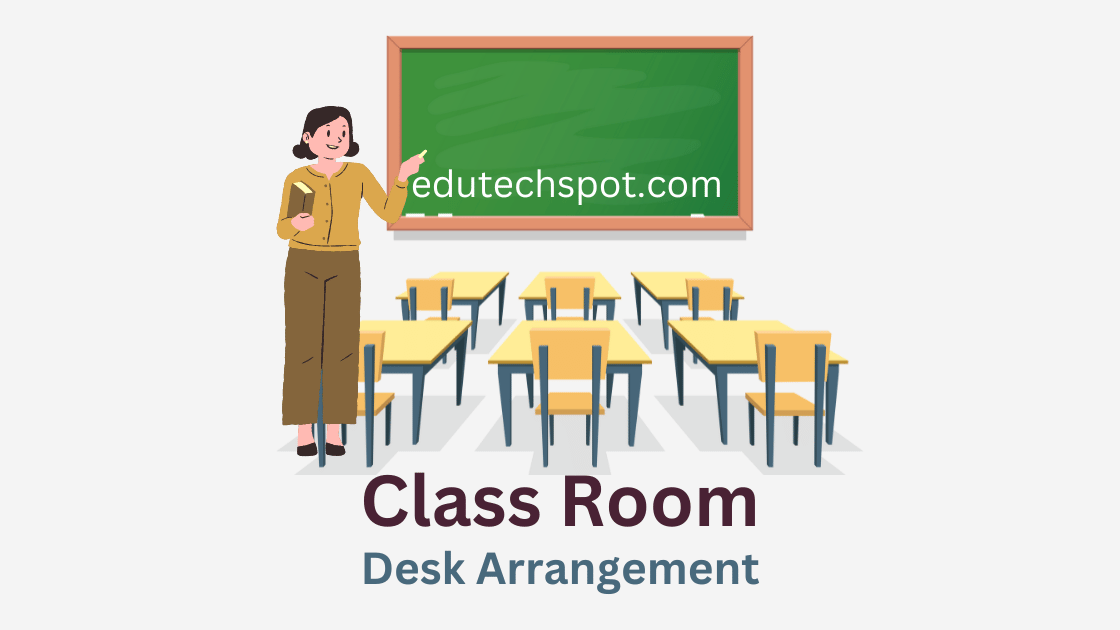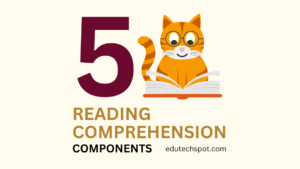Classroom Desk Arrangement Ideas. Are you looking for creative and effective ways to arrange desks in your classroom? Look no further!
DOUBLE E – Classroom Desk Arrangement Ideas
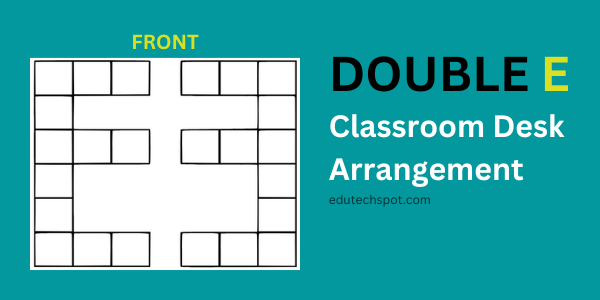
The double E classroom desk arrangement, the first Classroom Desk Arrangement Ideas, is a configuration for arranging desks in a classroom. It involves placing desks in two rows facing each other, forming a shape that resembles the letter “E”. This arrangement allows for easy movement and interaction between students, as well as visibility and accessibility for the teacher. It can be an effective setup for facilitating group work and discussion, as well as for individual tasks. However, it may not be suitable for larger class sizes or for certain teaching styles, as it may not provide enough space for all students to work comfortably or may not allow for adequate teacher supervision.
I preferred using this Classroom Desk Arrangement Ideas setup because it allowed me to easily monitor my students and facilitate group work by walking between rows. However, when my class size increased to 32 students, the limited space made this arrangement impractical.
PRO
- Facilitates interaction and communication between students: The double E arrangement allows students to easily see and hear each other, which can facilitate group work and discussions.
- Allows for easy movement and accessibility: The double E arrangement allows the teacher to easily move around the classroom and access all students, which can be beneficial for monitoring and assisting students.
- Promotes visibility and accessibility for the teacher: The double E arrangement allows the teacher to easily see and access all students, which can be helpful for managing the class and providing individualized support.
- Suitable for small to medium-sized classes: The double E arrangement is well-suited for small to medium-sized classes, as it provides enough space for students to work comfortably and allows for adequate teacher supervision.
- Can be adapted for different teaching styles and activities: The double E arrangement can be modified to suit different teaching styles and activities, such as group work or individual tasks.
CONS
There are also some potential drawbacks or disadvantages to using the double E desk arrangement in a classroom:
- May not be suitable for larger class sizes: The double E arrangement may not be suitable for larger class sizes, as it may not provide enough space for all students to work comfortably or may not allow for adequate teacher supervision.
- Limited privacy and individual space: The double E arrangement may not provide enough privacy or individual space for students to work independently, which may be a disadvantage for certain teaching styles or activities.
- May not be suitable for certain teaching styles: The double E arrangement may not be suitable for certain teaching styles that require a more formal or structured setup, such as lectures or presentations.
- Limited flexibility: The double E arrangement may not be as flexible as other desk arrangements, as it is more difficult to rearrange or modify the layout of the desks.
- May not be suitable for certain physical environments: The double E arrangement may not be suitable for certain physical environments, such as classrooms with limited space or uneven flooring.
PAIRS – Classroom Desk Arrangement Ideas
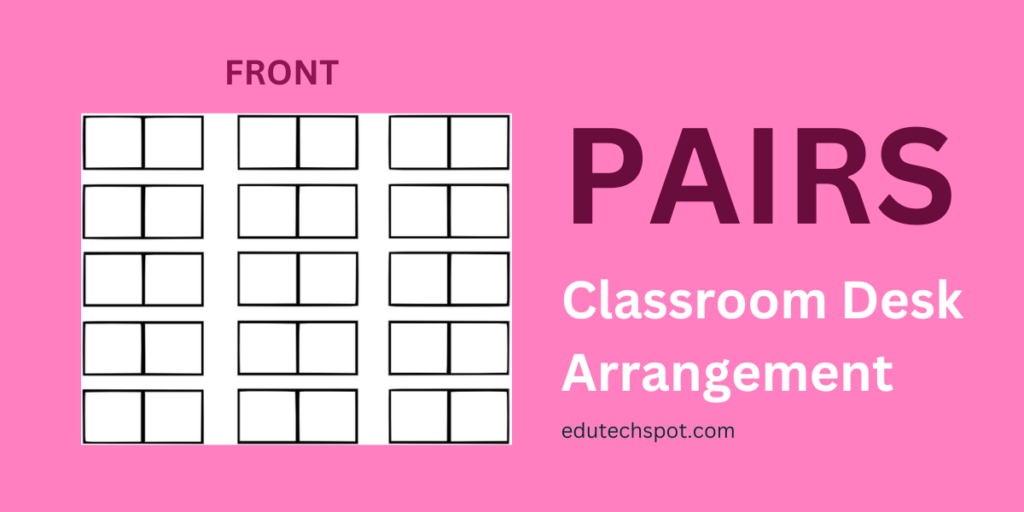
THe next Classroom Desk Arrangement Ideas, The pairs classroom desk arrangement is a configuration for arranging desks in a classroom. It involves placing desks in rows with pairs of desks facing each other. This arrangement allows for easy movement and interaction between students, as well as visibility and accessibility for the teacher. It can be an effective setup for facilitating group work and discussion, as well as for individual tasks. However, it may not be suitable for larger class sizes or for certain teaching styles, as it may not provide enough space for all students to work comfortably or may not allow for adequate teacher supervision.
An oldy but a goodie. This setup works well for partner work. You can also do groups of three and cut out one of the rows.
PRO
- Facilitates interaction and communication between students: The pairs arrangement allows students to easily see and hear each other, which can facilitate group work and discussions.
- Allows for easy movement and accessibility: The pairs arrangement allows the teacher to easily move around the classroom and access all students, which can be beneficial for monitoring and assisting students.
- Promotes visibility and accessibility for the teacher: The pairs arrangement allows the teacher to easily see and access all students, which can be helpful for managing the class and providing individualized support.
- Suitable for small to medium-sized classes: The pairs arrangement is well-suited for small to medium-sized classes, as it provides enough space for students to work comfortably and allows for adequate teacher supervision.
- Can be adapted for different teaching styles and activities: The pairs arrangement can be modified to suit different teaching styles and activities, such as group work or individual tasks.
- Can be easily rearranged: The pairs arrangement is relatively easy to rearrange, which can be useful for adapting to different teaching styles or activities.
CONS
- May not be suitable for larger class sizes: The pairs arrangement may not be suitable for larger class sizes, as it may not provide enough space for all students to work comfortably or may not allow for adequate teacher supervision.
- Limited privacy and individual space: The pairs arrangement may not provide enough privacy or individual space for students to work independently, which may be a disadvantage for certain teaching styles or activities.
- May not be suitable for certain teaching styles: The pairs arrangement may not be suitable for certain teaching styles that require a more formal or structured setup, such as lectures or presentations.
- Limited flexibility: The pairs arrangement may not be as flexible as other desk arrangements, as it is more difficult to rearrange or modify the layout of the desks.
- May not be suitable for certain physical environments: The pairs arrangement may not be suitable for certain physical environments, such as classrooms with limited space or uneven flooring.
Double Horseshoe – Classroom Desk Arrangement Ideas
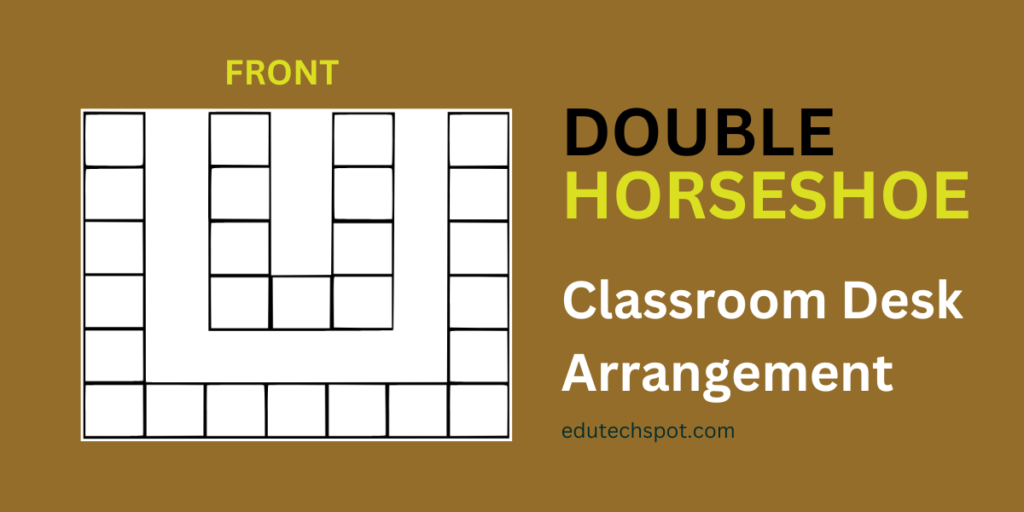
furthermore, Classroom Desk Arrangement Ideas of The double horseshoe desk arrangement is a configuration for arranging desks in a classroom. It involves placing desks in two semi-circle shapes, with the desks facing inward towards the center of the horseshoe. This arrangement allows for easy movement and interaction between students, as well as visibility and accessibility for the teacher. It can be an effective setup for facilitating group work and discussion, as well as for individual tasks. However, it may not be suitable for larger class sizes or for certain teaching styles, as it may not provide enough space for all students to work comfortably or may not allow for adequate teacher supervision.
Some benefits of the double horseshoe desk arrangement include the ability to easily facilitate group discussions, as all students are facing each other and can easily see and hear each other. It also allows the teacher to move freely around the classroom and easily observe and assist students. However, this setup may not be suitable for larger class sizes, as it may not provide enough space for all students to work comfortably or may not allow for adequate teacher supervision. Additionally, this arrangement may not be suitable for certain teaching styles or activities, as it may not provide enough privacy or individual space for students to work independently.
PRO
- Facilitates interaction and communication between students: The double horseshoe arrangement allows students to easily see and hear each other, which can facilitate group work and discussions.
- Allows for easy movement and accessibility: The double horseshoe arrangement allows the teacher to easily move around the classroom and access all students, which can be beneficial for monitoring and assisting students.
- Promotes visibility and accessibility for the teacher: The double horseshoe arrangement allows the teacher to easily see and access all students, which can be helpful for managing the class and providing individualized support.
- Suitable for small to medium-sized classes: The double horseshoe arrangement is well-suited for small to medium-sized classes, as it provides enough space for students to work comfortably and allows for adequate teacher supervision.
- Can be adapted for different teaching styles and activities: The double horseshoe arrangement can be modified to suit different teaching styles and activities, such as group work or individual tasks.
- Creates a sense of community: The double horseshoe arrangement can create a sense of community and inclusivity in the classroom, as all students are facing each other and can easily see and hear each other.
CONS
- May not be suitable for larger class sizes: The double horseshoe arrangement may not be suitable for larger class sizes, as it may not provide enough space for all students to work comfortably or may not allow for adequate teacher supervision.
- Limited privacy and individual space: The double horseshoe arrangement may not provide enough privacy or individual space for students to work independently, which may be a disadvantage for certain teaching styles or activities.
- May not be suitable for certain teaching styles: The double horseshoe arrangement may not be suitable for certain teaching styles that require a more formal or structured setup, such as lectures or presentations.
- Limited flexibility: The double horseshoe arrangement may not be as flexible as other desk arrangements, as it is more difficult to rearrange or modify the layout of the desks.
- May not be suitable for certain physical environments: The double horseshoe arrangement may not be suitable for certain physical environments, such as classrooms with limited space or uneven flooring.
- May not be suitable for certain teaching activities: The double horseshoe arrangement may not be suitable for certain teaching activities that require more individual space or privacy, such as taking exams or completing individual work.
Modified Double Horseshoe – Classroom Desk Arrangement Ideas
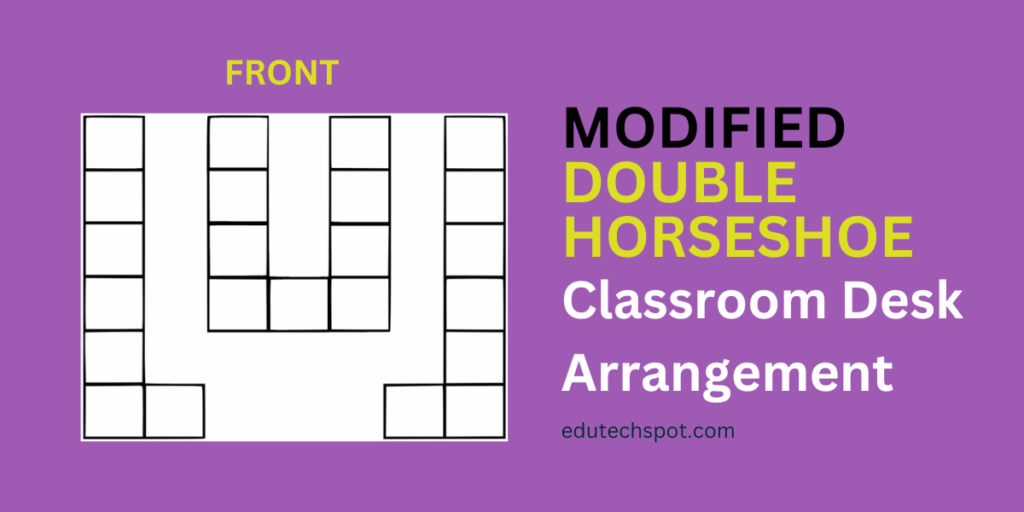
I love this Classroom Desk Arrangement Ideas. The modified double horseshoe desk arrangement is a variation of the double horseshoe desk arrangement. It involves placing desks in a semi-circle shape, with the desks facing inward towards the center of the horseshoe, but with one row of desks facing the opposite direction. This arrangement combines the benefits of the double horseshoe arrangement, such as facilitating interaction and communication between students and allowing for easy movement and accessibility, with the benefits of a traditional classroom setup, such as providing more individual space and privacy for students. However, like the double horseshoe arrangement, the modified double horseshoe arrangement may not be suitable for larger class sizes, certain teaching styles, or certain physical environments.
PRO
- Facilitates interaction and communication between students: The modified double horseshoe arrangement allows students to easily see and hear each other, which can facilitate group work and discussions.
- Allows for easy movement and accessibility: The modified double horseshoe arrangement allows the teacher to easily move around the classroom and access all students, which can be beneficial for monitoring and assisting students.
- Promotes visibility and accessibility for the teacher: The modified double horseshoe arrangement allows the teacher to easily see and access all students, which can be helpful for managing the class and providing individualized support.
- Suitable for small to medium-sized classes: The modified double horseshoe arrangement is well-suited for small to medium-sized classes, as it provides enough space for students to work comfortably and allows for adequate teacher supervision.
- Can be adapted for different teaching styles and activities: The modified double horseshoe arrangement can be modified to suit different teaching styles and activities, such as group work or individual tasks.
- Creates a sense of community: The modified double horseshoe arrangement can create a sense of community and inclusivity in the classroom, as all students are facing each other and can easily see and hear each other.
- Provides more individual space and privacy: The modified double horseshoe arrangement provides more individual space and privacy for students compared to the traditional double horseshoe arrangement, as one row of desks is facing the opposite direction. This may be beneficial for certain teaching styles or activities that require more individual space or privacy, such as taking exams or completing individual work.
CONS
- May not be suitable for larger class sizes: The modified double horseshoe arrangement may not be suitable for larger class sizes, as it may not provide enough space for all students to work comfortably or may not allow for adequate teacher supervision.
- May not be suitable for certain teaching styles: The modified double horseshoe arrangement may not be suitable for certain teaching styles that require a more formal or structured setup, such as lectures or presentations.
- Limited flexibility: The modified double horseshoe arrangement may not be as flexible as other desk arrangements, as it is more difficult to rearrange or modify the layout of the desks.
- May not be suitable for certain physical environments: The modified double horseshoe arrangement may not be suitable for certain physical environments, such as classrooms with limited space or uneven flooring.
- May not be suitable for certain teaching activities: The modified double horseshoe arrangement may not be suitable for certain teaching activities that require more group interaction or collaboration, as one row of desks is facing the opposite direction and may not be as easily accessible to other students.
Many “U”s – Classroom Desk Arrangement Ideas

The many Us desk arrangement, another Classroom Desk Arrangement Ideas, is a configuration for arranging desks in a classroom. It involves placing desks in a series of U-shaped formations, with the desks facing inward towards the center of the U. This arrangement allows for easy movement and interaction between students, as well as visibility and accessibility for the teacher. It can be an effective setup for facilitating group work and discussion, as well as for individual tasks. However, it may not be suitable for larger class sizes or for certain teaching styles, as it may not provide enough space for all students to work comfortably or may not allow for adequate teacher supervision.
The many Us desk arrangement is a flexible desk arrangement that can be used in a variety of settings and by a variety of educators. It is often used in primary and secondary schools, as well as in higher education settings. It can be suitable for a range of subject areas and teaching styles, and can be effective for facilitating group work and discussions, as well as for individual tasks. However, the many Us desk arrangement may not be suitable for larger class sizes or for certain teaching styles that require a more formal or structured setup, such as lectures or presentations.
PRO
- Facilitates interaction and communication between students: The many Us arrangement allows students to easily see and hear each other, which can facilitate group work and discussions.
- Allows for easy movement and accessibility: The many Us arrangement allows the teacher to easily move around the classroom and access all students, which can be beneficial for monitoring and assisting students.
- Promotes visibility and accessibility for the teacher: The many Us arrangement allows the teacher to easily see and access all students, which can be helpful for managing the class and providing individualized support.
- Suitable for small to medium-sized classes: The many Us arrangement is well-suited for small to medium-sized classes, as it provides enough space for students to work comfortably and allows for adequate teacher supervision.
- Can be adapted for different teaching styles and activities: The many Us arrangement can be modified to suit different teaching styles and activities, such as group work or individual tasks.
- Creates a sense of community: The many Us arrangement can create a sense of community and inclusivity in the classroom, as all students are facing each other and can easily see and hear each other.
- Provides more individual space and privacy: The many Us arrangement provides more individual space and privacy for students compared to other desk arrangements, as the desks are arranged in a U-shape with the desks facing inward towards the center of the U. This may be beneficial for certain teaching styles or activities that require more individual space or privacy, such as taking exams or completing individual work.
CONS
- May not be suitable for larger class sizes: The many Us arrangement may not be suitable for larger class sizes, as it may not provide enough space for all students to work comfortably or may not allow for adequate teacher supervision.
- May not be suitable for certain teaching styles: The many Us arrangement may not be suitable for certain teaching styles that require a more formal or structured setup, such as lectures or presentations.
- Limited flexibility: The many Us arrangement may not be as flexible as other desk arrangements, as it is more difficult to rearrange or modify the layout of the desks.
- May not be suitable for certain physical environments: The many Us arrangement may not be suitable for certain physical environments, such as classrooms with limited space or uneven flooring.
- May not be suitable for certain teaching activities: The many Us arrangement may not be suitable for certain teaching activities that require more group interaction or collaboration, as the desks are arranged in a U-shape and may not be as easily accessible to other students.
ROWS 2 – Classroom Desk Arrangement Ideas
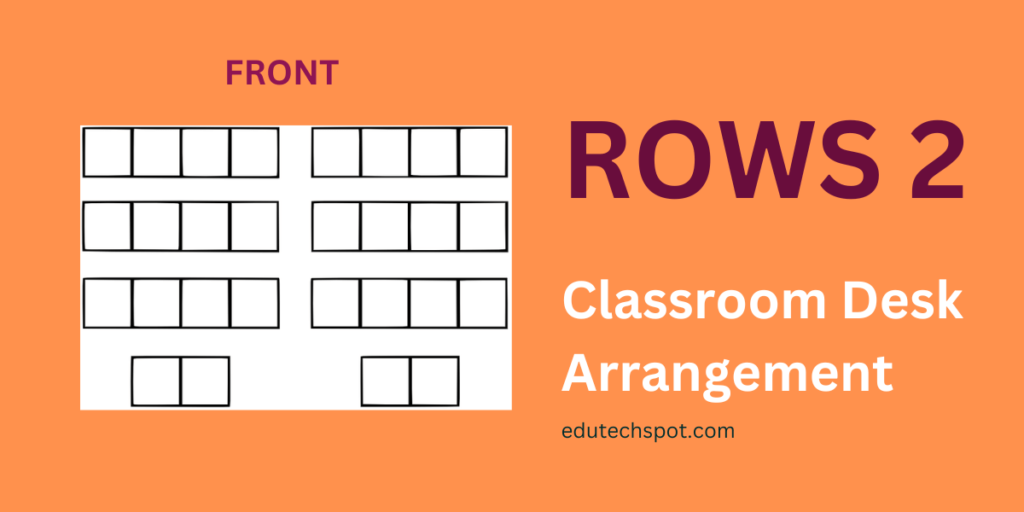
The rows 2 desk arrangement, influential Classroom Desk Arrangement Ideas, is a configuration for arranging desks in a classroom. It involves placing desks in two rows facing the front of the classroom, with an aisle in between the rows. This arrangement is often used in traditional classroom settings, and is well-suited for lectures, presentations, and other teaching styles that require a more formal or structured setup. It allows for easy movement and accessibility for the teacher, and promotes visibility and accessibility for all students. However, it may not be suitable for certain teaching styles or activities that require more interaction and collaboration between students, as the desks are arranged in rows and may not be as easily accessible to each other. It may also not be suitable for larger class sizes, as it may not provide enough space for all students to work comfortably or may not allow for adequate teacher supervision.
PRO
- Promotes visibility and accessibility for the teacher: The rows 2 arrangement allows the teacher to easily see and access all students, which can be helpful for managing the class and providing individualized support.
- Allows for easy movement and accessibility: The rows 2 arrangement allows the teacher to easily move around the classroom and access all students, which can be beneficial for monitoring and assisting students.
- Suitable for small to medium-sized classes: The rows 2 arrangement is well-suited for small to medium-sized classes, as it provides enough space for students to work comfortably and allows for adequate teacher supervision.
- Suitable for certain teaching styles: The rows 2 arrangement is well-suited for certain teaching styles that require a more formal or structured setup, such as lectures or presentations.
- Can be adapted for different teaching activities: The rows 2 arrangement can be modified to suit different teaching activities, such as individual work or group work.
- Can be easily rearranged: The rows 2 arrangement is relatively easy to rearrange, which can be useful for adapting to different teaching styles or activities.
- Can promote focus and attention: The rows 2 arrangement can promote focus and attention, as all students are facing the front of the classroom and may be less likely to be distracted by their surroundings.
CONS
- May not be suitable for larger class sizes: The rows 2 arrangement may not be suitable for larger class sizes, as it may not provide enough space for all students to work comfortably or may not allow for adequate teacher supervision.
- May not be suitable for certain teaching styles: The rows 2 arrangement may not be suitable for certain teaching styles that require more interaction and collaboration between students, as the desks are arranged in rows and may not be as easily accessible to each other.
- Limited flexibility: The rows 2 arrangement may not be as flexible as other desk arrangements, as it is more difficult to rearrange or modify the layout of the desks.
- May not be suitable for certain physical environments: The rows 2 arrangement may not be suitable for certain physical environments, such as classrooms with limited space or uneven flooring.
- May not be suitable for certain teaching activities: The rows 2 arrangement may not be suitable for certain teaching activities that require more group interaction or collaboration, as the desks are arranged in rows and may not be as easily accessible to other students.
- May not provide enough privacy or individual space: The rows 2 arrangement may not provide enough privacy or individual space for students to work independently, which may be a disadvantage for certain teaching styles or activities.
Rows & Lines – Classroom Desk Arrangement Ideas
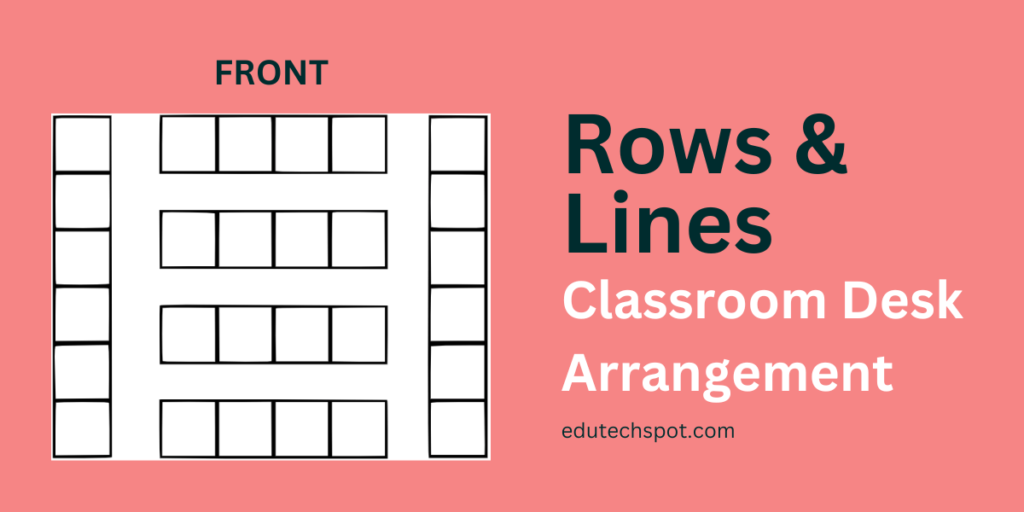
The rows and lines desk arrangement, unusual Classroom Desk Arrangement Ideas, is a configuration for arranging desks in a classroom. It involves placing desks in rows facing the front of the classroom, with aisles in between the rows, and also placing desks in lines perpendicular to the rows. This arrangement allows for a combination of individual and group work, as some students may be seated in rows facing the front of the classroom and others may be seated in lines facing their peers. It allows for easy movement and accessibility for the teacher, and promotes visibility and accessibility for all students. However, it may not be suitable for larger class sizes, as it may not provide enough space for all students to work comfortably or may not allow for adequate teacher supervision. It may also not be suitable for certain teaching styles or activities that require a more formal or structured setup, as the desks are arranged in a less traditional configuration.
PRO
- Promotes visibility and accessibility for the teacher: The rows and lines arrangement allows the teacher to easily see and access all students, which can be helpful for managing the class and providing individualized support.
- Allows for easy movement and accessibility: The rows and lines arrangement allows the teacher to easily move around the classroom and access all students, which can be beneficial for monitoring and assisting students.
- Suitable for small to medium-sized classes: The rows and lines arrangement is well-suited for small to medium-sized classes, as it provides enough space for students to work comfortably and allows for adequate teacher supervision.
- Can be adapted for different teaching styles and activities: The rows and lines arrangement can be modified to suit different teaching styles and activities, such as group work or individual tasks.
- Can facilitate both individual and group work: The rows and lines arrangement allows for a combination of individual and group work, as some students may be seated in rows facing the front of the classroom and others may be seated in lines facing their peers.
- Can be easily rearranged: The rows and lines arrangement is relatively easy to rearrange, which can be useful for adapting to different teaching styles or activities.
- Can promote focus and attention: The rows and lines arrangement can promote focus and attention, as some students are facing the front of the classroom and may be less likely to be distracted by their surroundings.
CONS
- May not be suitable for larger class sizes: The rows and lines arrangement may not be suitable for larger class sizes, as it may not provide enough space for all students to work comfortably or may not allow for adequate teacher supervision.
- May not be suitable for certain teaching styles: The rows and lines arrangement may not be suitable for certain teaching styles that require a more formal or structured setup, such as lectures or presentations.
- Limited flexibility: The rows and lines arrangement may not be as flexible as other desk arrangements, as it is more difficult to rearrange or modify the layout of the desks.
- May not be suitable for certain physical environments: The rows and lines arrangement may not be suitable for certain physical environments, such as classrooms with limited space or uneven flooring.
- May not be suitable for certain teaching activities: The rows and lines arrangement may not be suitable for certain teaching activities that require more group interaction or collaboration, as the desks are arranged in a less traditional configuration and may not be as easily accessible to other students.
- May not provide enough privacy or individual space: The rows and lines arrangement may not provide enough privacy or individual space for students to work independently, which may be a disadvantage for certain teaching styles or activities.
Rows – Classroom Desk Arrangement Ideas
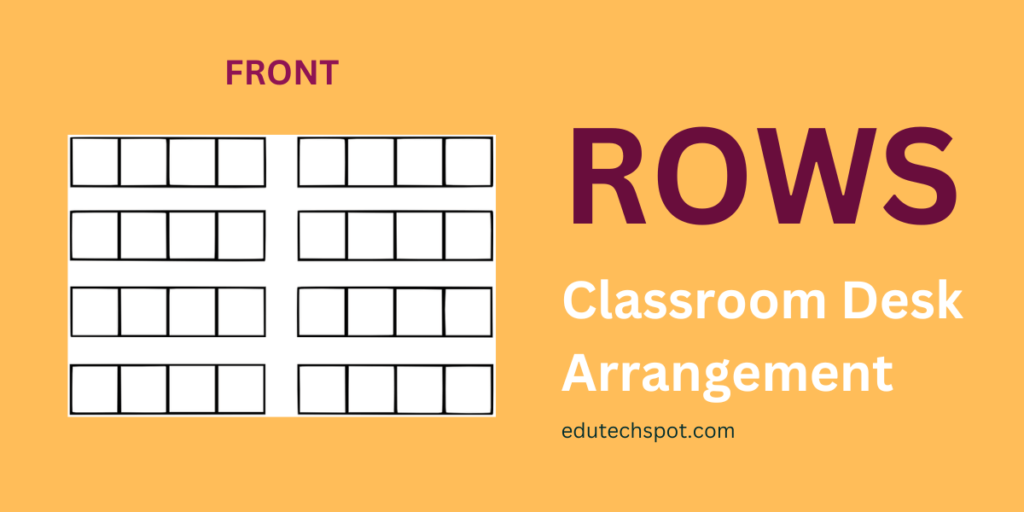
Love simpler Classroom Desk Arrangement Ideas? use this instead. The rows desk arrangement is a configuration for arranging desks in a classroom. It involves placing desks in rows facing the front of the classroom, with an aisle in between the rows. This arrangement is often used in traditional classroom settings, and is well-suited for lectures, presentations, and other teaching styles that require a more formal or structured setup. It allows for easy movement and accessibility for the teacher, and promotes visibility and accessibility for all students. However, it may not be suitable for certain teaching styles or activities that require more interaction and collaboration between students, as the desks are arranged in rows and may not be as easily accessible to each other. It may also not be suitable for larger class sizes, as it may not provide enough space for all students to work comfortably or may not allow for adequate teacher supervision.
PRO
- Promotes visibility and accessibility for the teacher: The rows arrangement allows the teacher to easily see and access all students, which can be helpful for managing the class and providing individualized support.
- Allows for easy movement and accessibility: The rows arrangement allows the teacher to easily move around the classroom and access all students, which can be beneficial for monitoring and assisting students.
- Suitable for small to medium-sized classes: The rows arrangement is well-suited for small to medium-sized classes, as it provides enough space for students to work comfortably and allows for adequate teacher supervision.
- Suitable for certain teaching styles: The rows arrangement is well-suited for certain teaching styles that require a more formal or structured setup, such as lectures or presentations.
- Can be adapted for different teaching activities: The rows arrangement can be modified to suit different teaching activities, such as individual work or group work.
- Can be easily rearranged: The rows arrangement is relatively easy to rearrange, which can be useful for adapting to different teaching styles or activities.
- Can promote focus and attention: The rows arrangement can promote focus and attention, as all students are facing the front of the classroom and may be less likely to be distracted by their surroundings.
CONS
- May not be suitable for larger class sizes: The rows arrangement may not be suitable for larger class sizes, as it may not provide enough space for all students to work comfortably or may not allow for adequate teacher supervision.
- May not be suitable for certain teaching styles: The rows arrangement may not be suitable for certain teaching styles that require more interaction and collaboration between students, as the desks are arranged in rows and may not be as easily accessible to each other.
- Limited flexibility: The rows arrangement may not be as flexible as other desk arrangements, as it is more difficult to rearrange or modify the layout of the desks.
- May not be suitable for certain physical environments: The rows arrangement may not be suitable for certain physical environments, such as classrooms with limited space or uneven flooring.
- May not be suitable for certain teaching activities: The rows arrangement may not be suitable for certain teaching activities that require more group interaction or collaboration, as the desks are arranged in rows and may not be as easily accessible to other students.
- May not provide enough privacy or individual space: The rows arrangement may not provide enough privacy or individual space for students to work independently, which may be a disadvantage for certain teaching styles or activities.
Stadium Seating – Classroom Desk Arrangement Ideas
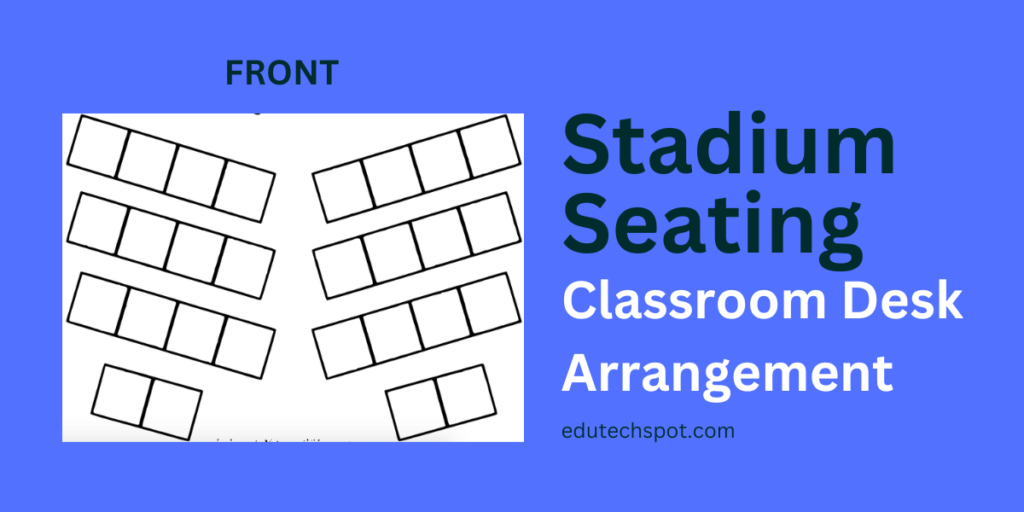
Extraordinary but effective Classroom Desk Arrangement Ideas, The stadium seating classroom desk arrangement is a configuration for arranging desks in a classroom. It involves placing desks in rows on a sloped or tiered floor, with the rows facing the front of the classroom. This arrangement is often used in lecture hall settings, and is well-suited for lectures, presentations, and other teaching styles that require a more formal or structured setup. It allows for easy movement and accessibility for the teacher, and promotes visibility and accessibility for all students. However, it may not be suitable for certain teaching styles or activities that require more interaction and collaboration between students, as the desks are arranged in rows and may not be as easily accessible to each other. It may also not be suitable for larger class sizes, as it may not provide enough space for all students to work comfortably or may not allow for adequate teacher supervision.
PRO
- Promotes visibility and accessibility for the teacher: The stadium seating arrangement allows the teacher to easily see and access all students, which can be helpful for managing the class and providing individualized support.
- Allows for easy movement and accessibility: The stadium seating arrangement allows the teacher to easily move around the classroom and access all students, which can be beneficial for monitoring and assisting students.
- Suitable for small to medium-sized classes: The stadium seating arrangement is well-suited for small to medium-sized classes, as it provides enough space for students to work comfortably and allows for adequate teacher supervision.
- Suitable for certain teaching styles: The stadium seating arrangement is well-suited for certain teaching styles that require a more formal or structured setup, such as lectures or presentations.
- Can be adapted for different teaching activities: The stadium seating arrangement can be modified to suit different teaching activities, such as individual work or group work.
- Can be easily rearranged: The stadium seating arrangement is relatively easy to rearrange, which can be useful for adapting to different teaching styles or activities.
- Can promote focus and attention: The stadium seating arrangement can promote focus and attention, as all students are facing the front of the classroom and may be less likely to be distracted by their surroundings.
- Can provide a more immersive learning experience: The stadium seating arrangement can provide a more immersive learning experience, as students are seated on a sloped or tiered floor and can easily see and hear the teacher and any visual aids or multimedia presentations.
CONS
- May not be suitable for larger class sizes: The stadium seating arrangement may not be suitable for larger class sizes, as it may not provide enough space for all students to work comfortably or may not allow for adequate teacher supervision.
- May not be suitable for certain teaching styles: The stadium seating arrangement may not be suitable for certain teaching styles that require more interaction and collaboration between students, as the desks are arranged in rows and may not be as easily accessible to each other.
- Limited flexibility: The stadium seating arrangement may not be as flexible as other desk arrangements, as it is more difficult to rearrange or modify the layout of the desks.
- May not be suitable for certain physical environments: The stadium seating arrangement may not be suitable for certain physical environments, such as classrooms with limited space or uneven flooring.
- May not be suitable for certain teaching activities: The stadium seating arrangement may not be suitable for certain teaching activities that require more group interaction or collaboration, as the desks are arranged in rows and may not be as easily accessible to other students.
- May not provide enough privacy or individual space: The stadium seating arrangement may not provide enough privacy or individual space for students to work independently, which may be a disadvantage for certain teaching styles or activities.
- May require specialized flooring or seating: The stadium seating arrangement may require specialized flooring or seating, which may be more costly or difficult to install or maintain.
Group of 6

The group of 6 classroom desk arrangement is a configuration for arranging desks in a classroom. It involves placing desks in groups of 6, with the desks arranged in a circular or hexagonal configuration. This arrangement is well-suited for group work and collaboration, as it allows students to easily see and access each other. It also allows for easy movement and accessibility for the teacher, and promotes visibility and accessibility for all students. However, it may not be suitable for certain teaching styles or activities that require a more formal or structured setup, such as lectures or presentations. It may also not be suitable for larger class sizes, as it may not provide enough space for all students to work comfortably or may not allow for adequate teacher supervision.
PRO
- Promotes interaction and collaboration: The group of 6 arrangement allows students to easily see and access each other, which can facilitate interaction and collaboration.
- Allows for easy movement and accessibility: The group of 6 arrangement allows the teacher to easily move around the classroom and access all students, which can be beneficial for monitoring and assisting students.
- Suitable for small to medium-sized classes: The group of 6 arrangement is well-suited for small to medium-sized classes, as it provides enough space for students to work comfortably and allows for adequate teacher supervision.
- Suitable for certain teaching styles: The group of 6 arrangement is well-suited for certain teaching styles that require more interaction and collaboration between students, such as group work or project-based learning.
- Can be adapted for different teaching activities: The group of 6 arrangement can be modified to suit different teaching activities, such as individual work or group work.
- Can be easily rearranged: The group of 6 arrangement is relatively easy to rearrange, which can be useful for adapting to different teaching styles or activities.
- Can promote focus and attention: The group of 6 arrangement can promote focus and attention, as students are seated in a circular or hexagonal configuration and may be less likely to be distracted by their surroundings.
CONS
- May not be suitable for larger class sizes: The group of 6 arrangement may not be suitable for larger class sizes, as it may not provide enough space for all students to work comfortably or may not allow for adequate teacher supervision.
- May not be suitable for certain teaching styles: The group of 6 arrangement may not be suitable for certain teaching styles that require a more formal or structured setup, such as lectures or presentations.
- Limited flexibility: The group of 6 arrangement may not be as flexible as other desk arrangements, as it is more difficult to rearrange or modify the layout of the desks.
- May not be suitable for certain physical environments: The group of 6 arrangement may not be suitable for certain physical environments, such as classrooms with limited space or uneven flooring.
- May not be suitable for certain teaching activities: The group of 6 arrangement may not be suitable for certain teaching activities that require more individual work or less collaboration, as the desks are arranged in a circular or hexagonal configuration and may not be as easily accessible to other students.
- May not provide enough privacy or individual space: The group of 6 arrangement may not provide enough privacy or individual space for students to work independently, which may be a disadvantage for certain teaching styles or activities.
Group of 8
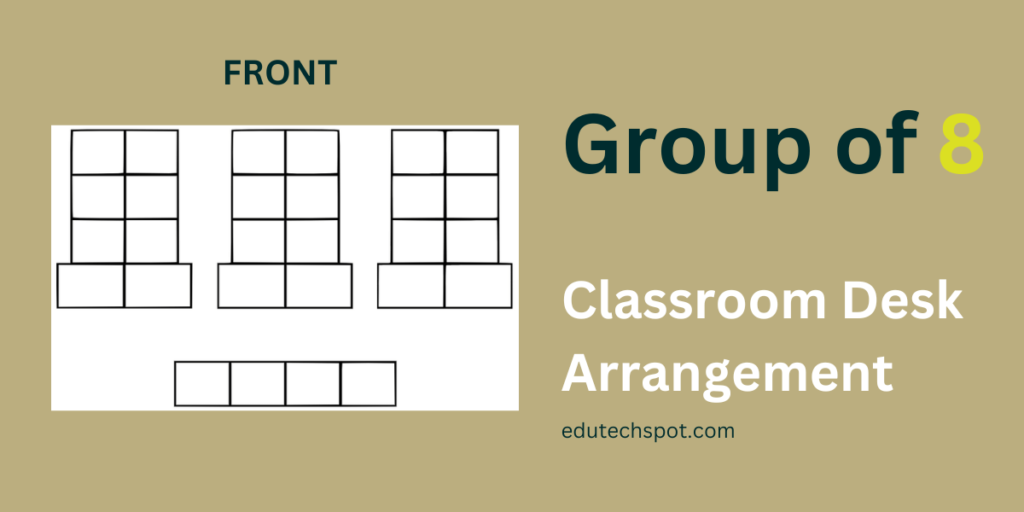
One of the things I really appreciate about this desk arrangement is that it’s effective even if you don’t have a particularly large classroom. It allows me to move around and access each student’s desk with ease, which is helpful for monitoring and assisting students. Additionally, it makes it easy to manage group or team work, which is a key feature for certain teaching styles and activities. Overall, I find this desk arrangement to be highly functional and effective in a variety of classroom settings.
PRO
- Promotes interaction and collaboration: The group of 8 arrangement allows students to easily see and access each other, which can facilitate interaction and collaboration.
- Allows for easy movement and accessibility: The group of 8 arrangement allows the teacher to easily move around the classroom and access all students, which can be beneficial for monitoring and assisting students.
- Suitable for small to medium-sized classes: The group of 8 arrangement is well-suited for small to medium-sized classes, as it provides enough space for students to work comfortably and allows for adequate teacher supervision.
- Suitable for certain teaching styles: The group of 8 arrangement is well-suited for certain teaching styles that require more interaction and collaboration between students, such as group work or project-based learning.
- Can be adapted for different teaching activities: The group of 8 arrangement can be modified to suit different teaching activities, such as individual work or group work.
- Can be easily rearranged: The group of 8 arrangement is relatively easy to rearrange, which can be useful for adapting to different teaching styles or activities.
- Can promote focus and attention: The group of 8 arrangement can promote focus and attention, as students are seated in a circular or hexagonal configuration and may be less likely to be distracted by their surroundings.
- Can provide a more immersive learning experience: The group of 8 arrangement can provide a more immersive learning experience, as students are seated in a circular or hexagonal configuration and can easily see and hear the teacher and any visual aids or multimedia presentations.
CONS
- May not be suitable for larger class sizes: The group of 8 arrangement may not be suitable for larger class sizes, as it may not provide enough space for all students to work comfortably or may not allow for adequate teacher supervision.
- May not be suitable for certain teaching styles: The group of 8 arrangement may not be suitable for certain teaching styles that require a more formal or structured setup, such as lectures or presentations.
- Limited flexibility: The group of 8 arrangement may not be as flexible as other desk arrangements, as it is more difficult to rearrange or modify the layout of the desks.
- May not be suitable for certain physical environments: The group of 8 arrangement may not be suitable for certain physical environments, such as classrooms with limited space or uneven flooring.
- May not be suitable for certain teaching activities: The group of 8 arrangement may not be suitable for certain teaching activities that require more individual work or less collaboration, as the desks are arranged in a circular or hexagonal configuration and may not be as easily accessible to other students.
- May not provide enough privacy or individual space: The group of 8 arrangement may not provide enough privacy or individual space for students to work independently, which may be a disadvantage for certain teaching styles or activities.
Group of 9

Group of 6
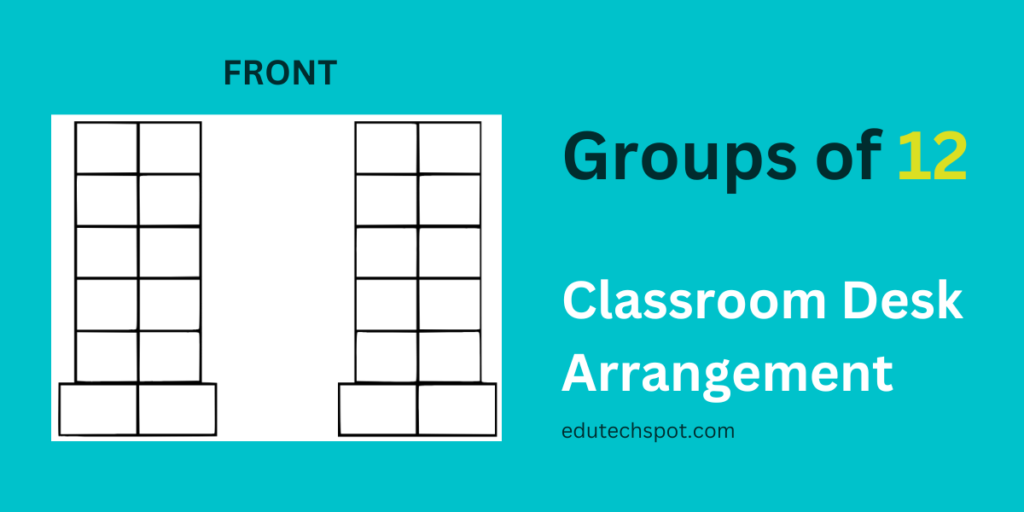
Here are some top classroom desk arrangement ideas to help you optimize your learning environment and engage your students:

- The traditional rows setup: This classic arrangement is simple and efficient, with desks arranged in rows facing the front of the room and aisles in between. This allows the teacher to easily see and address the entire class.
- The horseshoe setup: For a more interactive and collaborative learning experience, try arranging desks in a U-shape, with the open end facing the front of the room. This allows students to easily see and talk to each other, promoting discussion and teamwork.
- The circular setup: Another option for fostering collaboration and discussion is the circular desk arrangement, with desks arranged in a circle and the teacher’s desk in the center. This setup creates a more informal and interactive learning environment.
- The breakout groups setup: If you’re looking to facilitate group work and project-based learning activities, consider arranging desks in small groups, with each group facing each other. This allows students to work together and share ideas more easily.
- The flexible seating setup: For a more dynamic and flexible learning environment, consider replacing traditional desks with a variety of seating options such as bean bag chairs, cushioned stools, or standing desks. This allows students to choose the seating option that works best for them and promotes movement and engagement.
No matter which desk arrangement you choose, it’s important to consider the specific needs and goals of your students and the activities being conducted in the classroom. Involving students in the process of deciding on the desk arrangement can also help to foster a sense of ownership and engagement in their learning environment. So go ahead and try out these classroom desk arrangement ideas to optimize your classroom and enhance student learning.
Factors to Consider
Classroom layout
The layout of a classroom refers to the arrangement of furniture, equipment, and other elements within the space. A well-designed classroom layout can create a comfortable and functional learning environment that supports the needs and goals of students and teachers. There are many factors to consider when designing a classroom layout, such as the size and shape of the room, the number of students, the type of activities being conducted, and the availability of resources and technology.
Desk arrangements for classrooms
Desk arrangements refer to the way in which desks are arranged within a classroom. There are many different ways to arrange desks, each with its own benefits and drawbacks. For example, traditional rows of desks facing the front of the room are simple and efficient, but may not promote student interaction and collaboration. On the other hand, arrangements such as horseshoes or circles can foster discussion and teamwork, but may be less practical for larger classrooms or certain types of activities.
Classroom furniture arrangement
The furniture in a classroom plays a crucial role in creating a comfortable and functional learning environment. When arranging furniture, it’s important to consider the size and layout of the room, the number of students, and the type of activities being conducted. For example, desks and chairs should be positioned in a way that allows students to see and hear the teacher, while also providing enough space for movement and collaboration.
Classroom design ideas
The design of a classroom can have a big impact on student learning and engagement. When designing a classroom, it’s important to consider the needs and goals of the students, as well as the style and atmosphere that you want to create. Some ideas for designing a classroom might include adding color and interest through artwork and decorations, using flexible seating options to encourage movement and engagement, and incorporating technology and other resources to support student learning.
Classroom seating arrangements
The seating arrangement in a classroom can affect student learning and behavior in a number of ways. For example, students may be more engaged and focused if they are seated in a way that allows them to see and hear the teacher clearly, while a seating arrangement that promotes interaction and collaboration may be more suitable for group work or discussion-based activities. It’s important to consider the specific needs and goals of your students when selecting a seating arrangement.
Classroom layout for elementary students
The layout of a classroom for elementary students should be designed to support their developmental needs and learning style. For example, younger students may benefit from a layout that allows them to move around and explore the classroom, while also providing clear sight lines and minimal distractions. Furniture and equipment should be sized appropriately for smaller students, and the layout should allow for easy supervision and interaction with the teacher.
Classroom layout for middle school students
The layout of a classroom for middle school students should be designed to support their growing independence and increasing cognitive abilities. For example, the layout might include a mix of individual and group work spaces, as well as areas for hands-on activities and experimentation. Furniture and equipment should be sized appropriately for students of this age, and the layout should allow for a degree of flexibility to support different teaching styles and learning needs.
Classroom layout for high school students
The layout of a classroom for high school students should be designed to support their more advanced cognitive abilities and increasing independence. This might include a mix of individual and group work spaces, as well as areas for hands-on activities and experimentation. Furniture and equipment should be sized appropriately for older students, and the layout should allow for a degree of flexibility to support different teaching styles and learning needs.
Flexible seating classroom ideas
Flexible seating refers to the use of a variety of seating options in a classroom, rather than traditional desks and chairs. This approach allows students to choose the seating option that works best for them and promotes movement and engagement. Some ideas for flexible seating might include bean bag chairs, cushioned stools, standing desks, or even yoga balls. It’s important to consider the specific needs and goals of your students when selecting flexible seating options, and to make sure that the options are comfortable and safe.
Collaborative learning environment
A collaborative learning environment is one in which students work together to solve problems, share ideas, and learn from each other. This type of environment can be created through a variety of means, such as desk arrangements that promote interaction and discussion, group work activities, and the use of technology and other resources to support collaboration. A collaborative learning environment can foster teamwork, creativity, and critical thinking skills, and may be particularly effective for project-based learning or problem-based learning activities.
In conclusion, each of these factors – classroom layout, desk arrangements for classrooms, classroom furniture arrangement, classroom design ideas, classroom seating arrangements, classroom layout for elementary students, classroom layout for middle school students, classroom layout for high school students, flexible seating classroom ideas, and collaborative learning environment – can be important considerations when designing a classroom to optimize student learning and engagement. By taking into account the specific needs and goals of your students, and using a variety of strategies and resources, you can create a classroom environment that supports and enhances student learning.
